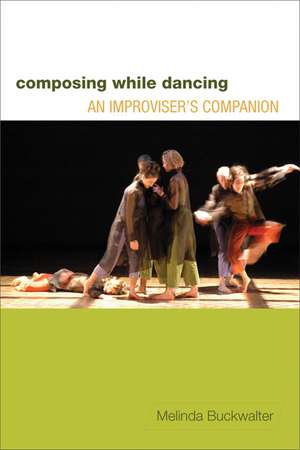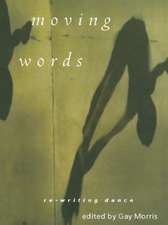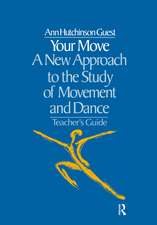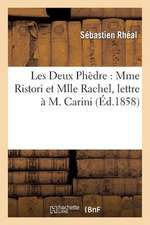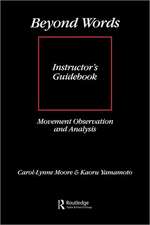Composing while Dancing: An Improviser’s Companion
Autor Melinda Buckwalteren Limba Engleză Paperback – 15 dec 2010
Composing while Dancing: An Improviser’s Companion examines the world of improvisational dance and the varied approaches to this art form. By introducing the improvisational strategies of twenty-six top contemporary artists of movement improvisation, Melinda Buckwalter offers a practical primer to the dance form. Each chapter focuses on an important aspect of improvisation including spatial relations, the eyes, and the dancing image. Included are sample practices from the artists profiled, exercises for further research, and a glossary of terms. Buckwalter gathers history, methods, interviews, and biographies in one book to showcase the many facets of improvisational dance and create an invaluable reference for dancers and dance educators.
Preț: 161.54 lei
Nou
Puncte Express: 242
Preț estimativ în valută:
30.91€ • 32.36$ • 25.58£
30.91€ • 32.36$ • 25.58£
Carte tipărită la comandă
Livrare economică 07-21 aprilie
Preluare comenzi: 021 569.72.76
Specificații
ISBN-13: 9780299248147
ISBN-10: 0299248143
Pagini: 244
Ilustrații: 22 b-w photos
Dimensiuni: 152 x 229 x 18 mm
Greutate: 0.34 kg
Ediția:1
Editura: University of Wisconsin Press
Colecția University of Wisconsin Press
ISBN-10: 0299248143
Pagini: 244
Ilustrații: 22 b-w photos
Dimensiuni: 152 x 229 x 18 mm
Greutate: 0.34 kg
Ediția:1
Editura: University of Wisconsin Press
Colecția University of Wisconsin Press
Recenzii
“Composing while Dancing is a treasure trove of dance improvisation information.”— Paul Langland, New York University
“A welcome addition to the sparse literature of movement improvisation. Through years of her own study, Buckwalter has gathered a cornucopia of improvisational practices from more than two dozen of the most intriguing (and underdocumented) movement artists working today. She then invites you, through the organization of the chapters and through her own energy and interest, to join the dance.”—Kent De Spain, author of Method to the Madness: Movement Improvisation in the Words of Its Practitioners
“An insightful, much-needed resource for those interested in dance improvisation. Budding young artists in particular will value the epilogue on developing their own practice.”—J. H. Roberts, CHOICE
Notă biografică
Melinda Buckwalter is coeditor of Contact Quarterly, a dance and improvisation journal. She lives in Massachusetts.
Cuprins
Introduction
There is Room for You
The Great Break into a Million Pieces
An Overview
How to Use This Book—Getting the Most from your Companion
Composing as Companion?
More Notes on Semantics
You Say Impro, I Say Improv
Chapter 1 Materia Prima
Introduction
Using What's Available: Forti, Dilley, Campbell
Dancing with All You've Got: Sgorbati, Duck
Going Beyond What You Do: Martin
Playing with What's Given: Bull, Reitz, Topf, Overlie, Forsythe
A Closing Thought about Material
Interlude—So many influences, so little time . . .
Chapter 2 Form: Dancing Takes Shape
Introduction
Ritual: Anna Halprin
Performance Practice: Deborah Hay
Ancient Memories: Eiko and Koma
A New Form of Dance: Steve Paxton
Studying Form: Richard Bull
From Chaos to Form through Play: Keith Hennessy
Articulating Forms: Nina Martin
Fostering Form: Penny Campbell
Emerging Forms: Susan Sgorbati
Frames as Forms: Mary Overlie
The Senses as Composers: Lisa Nelson
Forming a Dialogue of Spirit, Nature, and Culture: Suprapto Suryodarmo (Prapto)
Investigating Open Space Improvisation: Barbara Dilley
A Closing Thought about Form
Practices for Further Research
Interlude—Notes to myself: "No room for form with love this strong." (Rumi)
Chapter 3 Time Machines
Introduction
A Chance Encounter: Katie Duck
Options to Glacial Time: Nina Martin
Time Warp: Mary Overlie
Surprise: Min Tanaka
Shaping Time: Dana Reitz
Epic: Nancy Stark Smith
Time to Digest: Nancy Topf
Through the Looking Glass: Steve Paxton
Compressing Time: William Forsythe
A Sense of Time: Barbara Dilley
Back in Time: Lisa Nelson
A Closing Thought about Time
Practices for Further Research
Interlude—Notes to myself: Living Backwards
Chapter 4 Spacial Relations
Introduction
Palindrome: Richard Bull
The Grid: Barbara Dilley
Spherical Space: Paxton
The Global Underscore: Nancy Stark Smith
The Hot Spot: Nina Martin
Listen to the Space: Dana Reitz
Architecture: Mary Overlie
Room Writing: William Forsythe
Exit and Dance: Katie Duck
A Closing Thought about Space
Practices for Further Research
Interlude—Ma
Chapter 5 The Dancing Image
Introduction
The Red Square: Barbara Dilley
The Single Image Score: Lisa Nelson
Complete the Form and Neuro: Nina Martin
Poetic and Anatomical Imagery: Joan Skinner and Marsha Paludan et al.
Dynamic Anatomy: Nancy Topf
Becoming Butoh: Kazuo Ohno
Body Weather: Min Tanaka
Disappearing: Mary Overlie
A Closing Thought about the Dancing Image
Practices for Further Research
Interlude—Invisible Dances with Mary Overlie
Chapter 6 The Possibilities of Music
Introduction
Equals in Process: Judith Dunn and Bill Dixon
Integrated yet Independent: Penny Campbell
An Emerging Duet: Susan Sgorbati
A Dialogue of Forms: Richard Bull
Minimalists: Nancy Topf and Jon Gibson
Magpie Music Dance: Katie Duck
The Music in Movement: Dana Reitz
Carrying the Music: Kazuo Ohno
86 Aspects: Nancy Stark Smith and Mike Vargas
A Closing Thought about Music
Practices for Further Research
Interlude—Notes to myself: Listening
Chapter 7 The Eyes
Introduction
The Five Eye Practices: Barbara Dilley
Engaging the Eyes: Katie Duck
The Kinesthetics of Seeing: Lisa Nelson
The Eyes as an Image of Depth: Nancy Topf
Playing the Field: Nina Martin
Peripheral Vision: Steve Paxton
Cleaning the Windows of Perception: Suprapto Suryodarmo (Prapto)
A Closing Thought about the Eyes
Practices for Further Research
Interlude—Notes to myself: Catch It Out of the Corner of my Eye
Chapter 8 Partnering Science
Introduction
Comparative Anatomy of a Moving Body: Jennifer Monson
Embodying Complexity: Susan Sgorbati
Physics for the Body: Steve Paxton
A Research Proposal: Simone Forti
A Closing Thought about Partnering Science
Practices for Further Research
Interlude—Notes to myself on not knowing
Chapter 9 The Magical Object
Introduction
Taking Instructions from Objects: Lisa Nelson
Re-reify: Mary Overlie
Animate Dancing: Simone Forti
Drawing Dances: Dana Reitz
Wiggle Room: William Forsythe
Bytes: Pooh Kaye
Objects in Space: Nancy Topf
Not Only for Yourself: Min Tanaka
A Closing Thought about Objects
Practices for Further Research
Interlude–The objects begin to speak . . .
Appendices:
Who's Who and What's What in the Improviser's Companion
Dance-Maker Biographical Sketches and Contextual Information
Bibliography
Dance-Maker Selected Bibliographies and Further Reading
There is Room for You
The Great Break into a Million Pieces
An Overview
How to Use This Book—Getting the Most from your Companion
Composing as Companion?
More Notes on Semantics
You Say Impro, I Say Improv
Chapter 1 Materia Prima
Introduction
Using What's Available: Forti, Dilley, Campbell
Dancing with All You've Got: Sgorbati, Duck
Going Beyond What You Do: Martin
Playing with What's Given: Bull, Reitz, Topf, Overlie, Forsythe
A Closing Thought about Material
Interlude—So many influences, so little time . . .
Chapter 2 Form: Dancing Takes Shape
Introduction
Ritual: Anna Halprin
Performance Practice: Deborah Hay
Ancient Memories: Eiko and Koma
A New Form of Dance: Steve Paxton
Studying Form: Richard Bull
From Chaos to Form through Play: Keith Hennessy
Articulating Forms: Nina Martin
Fostering Form: Penny Campbell
Emerging Forms: Susan Sgorbati
Frames as Forms: Mary Overlie
The Senses as Composers: Lisa Nelson
Forming a Dialogue of Spirit, Nature, and Culture: Suprapto Suryodarmo (Prapto)
Investigating Open Space Improvisation: Barbara Dilley
A Closing Thought about Form
Practices for Further Research
Interlude—Notes to myself: "No room for form with love this strong." (Rumi)
Chapter 3 Time Machines
Introduction
A Chance Encounter: Katie Duck
Options to Glacial Time: Nina Martin
Time Warp: Mary Overlie
Surprise: Min Tanaka
Shaping Time: Dana Reitz
Epic: Nancy Stark Smith
Time to Digest: Nancy Topf
Through the Looking Glass: Steve Paxton
Compressing Time: William Forsythe
A Sense of Time: Barbara Dilley
Back in Time: Lisa Nelson
A Closing Thought about Time
Practices for Further Research
Interlude—Notes to myself: Living Backwards
Chapter 4 Spacial Relations
Introduction
Palindrome: Richard Bull
The Grid: Barbara Dilley
Spherical Space: Paxton
The Global Underscore: Nancy Stark Smith
The Hot Spot: Nina Martin
Listen to the Space: Dana Reitz
Architecture: Mary Overlie
Room Writing: William Forsythe
Exit and Dance: Katie Duck
A Closing Thought about Space
Practices for Further Research
Interlude—Ma
Chapter 5 The Dancing Image
Introduction
The Red Square: Barbara Dilley
The Single Image Score: Lisa Nelson
Complete the Form and Neuro: Nina Martin
Poetic and Anatomical Imagery: Joan Skinner and Marsha Paludan et al.
Dynamic Anatomy: Nancy Topf
Becoming Butoh: Kazuo Ohno
Body Weather: Min Tanaka
Disappearing: Mary Overlie
A Closing Thought about the Dancing Image
Practices for Further Research
Interlude—Invisible Dances with Mary Overlie
Chapter 6 The Possibilities of Music
Introduction
Equals in Process: Judith Dunn and Bill Dixon
Integrated yet Independent: Penny Campbell
An Emerging Duet: Susan Sgorbati
A Dialogue of Forms: Richard Bull
Minimalists: Nancy Topf and Jon Gibson
Magpie Music Dance: Katie Duck
The Music in Movement: Dana Reitz
Carrying the Music: Kazuo Ohno
86 Aspects: Nancy Stark Smith and Mike Vargas
A Closing Thought about Music
Practices for Further Research
Interlude—Notes to myself: Listening
Chapter 7 The Eyes
Introduction
The Five Eye Practices: Barbara Dilley
Engaging the Eyes: Katie Duck
The Kinesthetics of Seeing: Lisa Nelson
The Eyes as an Image of Depth: Nancy Topf
Playing the Field: Nina Martin
Peripheral Vision: Steve Paxton
Cleaning the Windows of Perception: Suprapto Suryodarmo (Prapto)
A Closing Thought about the Eyes
Practices for Further Research
Interlude—Notes to myself: Catch It Out of the Corner of my Eye
Chapter 8 Partnering Science
Introduction
Comparative Anatomy of a Moving Body: Jennifer Monson
Embodying Complexity: Susan Sgorbati
Physics for the Body: Steve Paxton
A Research Proposal: Simone Forti
A Closing Thought about Partnering Science
Practices for Further Research
Interlude—Notes to myself on not knowing
Chapter 9 The Magical Object
Introduction
Taking Instructions from Objects: Lisa Nelson
Re-reify: Mary Overlie
Animate Dancing: Simone Forti
Drawing Dances: Dana Reitz
Wiggle Room: William Forsythe
Bytes: Pooh Kaye
Objects in Space: Nancy Topf
Not Only for Yourself: Min Tanaka
A Closing Thought about Objects
Practices for Further Research
Interlude–The objects begin to speak . . .
Appendices:
Who's Who and What's What in the Improviser's Companion
Dance-Maker Biographical Sketches and Contextual Information
Bibliography
Dance-Maker Selected Bibliographies and Further Reading
Descriere
Composing while Dancing: An Improviser’s Companion examines the world of improvisational dance and the varied approaches to this art form. By introducing the improvisational strategies of twenty-six top contemporary artists of movement improvisation, Melinda Buckwalter offers a practical primer to the dance form. Each chapter focuses on an important aspect of improvisation including spatial relations, the eyes, and the dancing image. Included are sample practices from the artists profiled, exercises for further research, and a glossary of terms. Buckwalter gathers history, methods, interviews, and biographies in one book to showcase the many facets of improvisational dance and create an invaluable reference for dancers and dance educators.
